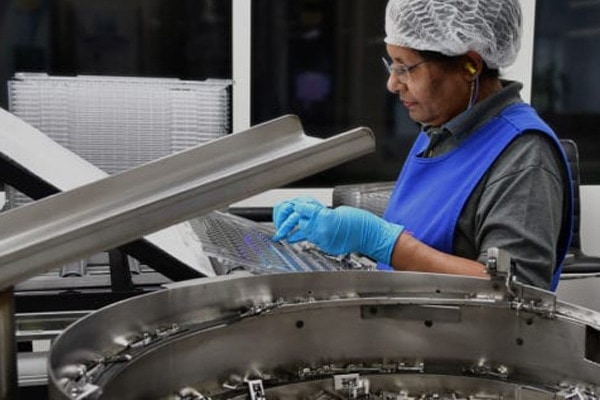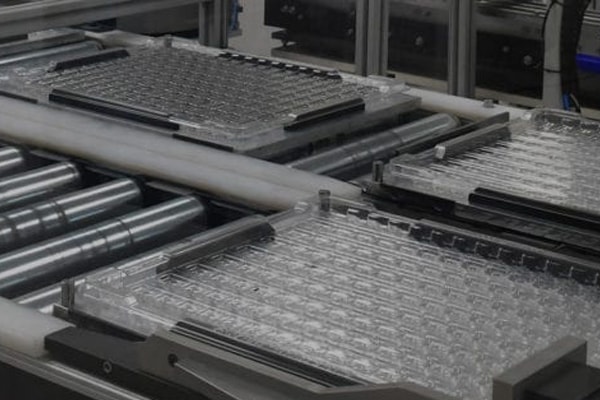Great emphasis falls on manufacturers to ensure the safe removal of contaminants large, small and sub microscopic. Failure to do so could have life changing and even fatal consequences.
Rigorous cleaning of medical device pressings is then vital and written into law by industry regulations, including Clean Room Standards (8). Indeed, sterilisation alone will not suffice, with legacy residue posing a very real and present threat to patient safety.
While there are different means of ridding a pressed component of particulates, oils and general contamination, technical cleaning and passivation are widely recognised as the most common and reliable.
In this article, we’ll explore both in more detail.
Technical Cleaning of Medical Device Components
Technical cleaning relies on state-of-the-art machinery, the like of which Clamason boast in both our UK and Slovakian plants.
Automatic and fully enclosed systems, with varying measures of cleanliness, those can be; 56-dyne level, a minimum metallic and non-metallic particle size of 127 microns and for medical customers the process is capable of Zero Bioburden.
The tests for these measures are performed both in house or through validated laboratories.
Capability on that scale brings with it increased versatility. Technical teams are suddenly equipped to clean hard to reach areas. Likewise, they can adopt a lighter touch when focusing on what could typically be described as ‘delicate’ instruments.
Yes, technical cleaning presents a welcome solution for pressings known to succumb to high pressure and steam.
Popular methods of technical cleaning include degreasing and solvent cleaning using ultrasonic technology. You won’t be surprised to learn these are processes Clamason are well versed in. Let’s take a closer look at them both.
Vapour Degreasing

Vapour Degreasing is a highly effective form of technical cleaning.
The process was commonplace in the 1980s before concerns surrounding its reliance on harmful chemicals saw many manufacturers abandon the method at the turn of the decade.
Modern solvent technology, including environmentally sound and low temperature cleaning contents, mean degreasing has re-emerged in recent years, rivalling the aqueous system that displaced it originally. The renewed process has a great many benefits, a reduced bioburden impact chief among them.
The cleaning procedure itself involves a setup consisting of two chambers, each filled with non-flammable solvent.
In one of said chambers, the solvent is heated to a boil which produces a vapour cloud designed to rise and meet surrounding cooling coils. The latter cause the vapours to condense before duly returning to their liquid state.
That same fluid is then channelled back to the second chamber, more accurately described as the rinse chamber.
Medical pressings themselves are put through the vapours and into the boil sump for initial cleaning. From here they progress to the rinse sump, now filled with clean solvent distilled from the aforementioned solvent vapours.
The high density and low surface tension of the solvents make for effective cleaning, superior to any system calling upon water. In addition, the final process involved is the drying of components which is done under vacuum. Thus is particularly effective at reducing staining on components.
Vapour degreasing lends itself to the cleaning of delicate components, far more so than aqueous cleaning can hope to. It has become a key service offering of Clamason’s in recent years and led to the successful cleaning and distribution of high-quality pressings globally.
Ultrasonic Technology
Solvent cleaning, which taps into ultrasonic technology, is another example of technical cleaning at its most advanced.
This method is guaranteed to wash away the smallest particles and enables the penetration of all varieties of medical pressing, even those containing obscure crevices. It does this by driving the cleaning solution deeper. Here’s how…
Ultrasonic cleaning is based on a physical effect born from waves being passed through a liquid, causing it to collide against an object. This process is referred to as Agitating.
It creates millions of minute bubbles which disintegrate, in doing so creating jets of plasma energy (as opposed to air).
The energy bursts connect with the surface of the object – naturally immersed in liquid – helping to do away with any contaminants present, including grime. This sequence is better known as Cavitation.
It makes for the rigorous cleaning of multiple instruments at any one time. Helpfully, any medical pressing passed through is cleaned and sterilised in one fell swoop.
Tapping into ultrasonic technology is another example of safe and efficient technical cleaning.
In both conventional degreasing and technical cleaning both of these systems can be integrated into a class 8 cleanroom, providing the customer with an end-to-end process.
Passivation

Passivation is proven to prevent corrosion of stainless steel once it has undergone a mechanical process, such as machining.
It relies on citric or nitric acid which conspire to remove free iron and iron compounds alike from stainless steel surfaces.
This helps to create a protective oxide layer, less inclined to chemically react with air or water and thus corrode. The protective layer itself is no more than a few molecules thick but – crucially – serves to safeguard the underlying metal.
While nitric acid is more commonly deployed, citric has superior environmental and safety qualities. It may not be as good an oxidiser as the nitric equivalent but that matters little given oxidising rinses can be used in post-treatment to compensate for that.
While passivation is certainly effective, the very fact it involves acids means extra provisions have to be in place during the cleaning process itself. Specialist handling equipment and safety devices are issued to engineers to ensure nobody is placed in any immediate danger. In addition, the process consumes a lot of energy, especially in the final drying operation compared to technical cleaning.
Similarly, strict protocols have to be put in place for the safe disposal of what is ultimately a hazardous waste.
Sadly, passivation cannot guarantee a smooth surface finish, which prompts many to opt instead for electropolishing. This is an intensive process which removes the oxide scale, along with any burrs, laser slag or ridges… although this is reflected in higher cost.
Performance
The importance of cleaning medical pressings to a high standard is obvious. Indeed, disinfection and sterilisation depend on it.
Sadly, there is no escaping the risk of inorganic contamination during pressing, which means there will always be a need for intense cleaning – in whatever form.
Over time however there has a been a clear shift towards technical cleaning as a preferred solution. This is both logical and predictable.
Technical cleaning is after all an environmentally friendly option that reduces the bioburden impact by dealing in low temperatures.
It presents an easy means of cleaning small components defined by complex detailing.
Just as importantly, it accelerates the process as a whole – allowing for multiple programmes to be run according to customer specifications. This helps clear backlogs and avoid bottle necks, things that can negatively impact production times.
Most importantly, it allows manufacturers to realise an incredibly high level of cleanliness. This translates to improved product performance and patient safety alike.
Finally, technical cleaning allows for items to be packed in a controlled environment soon afterwards, using the likes of bespoke trays. Alternatively they can be double bagged and packed into standard packaging, a process Clamason ourselves have adopted. Components for the likes of insulin pens and dry powder inhalers have gone through this exact procedure.
Technical cleaning is without doubt the modern approach allowing for components to be cleaned in a controlled environment and a safe manner, to brilliant effect.
Did you know stamping simulation can assist in the design of medical device components? Find out how.
